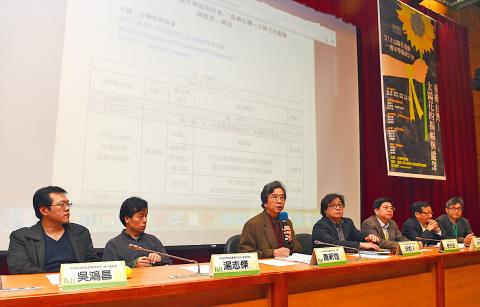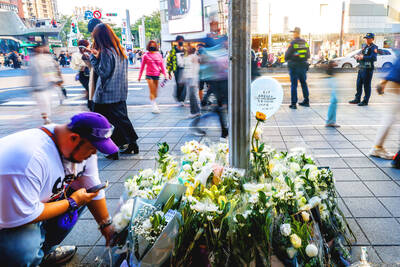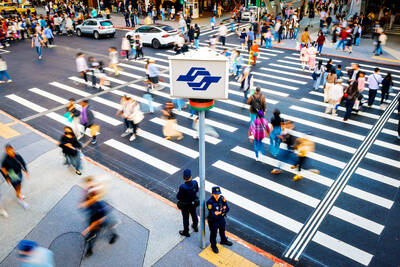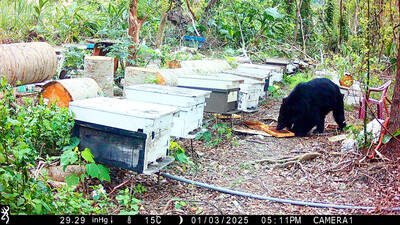The birth of the Sunflower movement might have been unexpected, but its emergence as a demonstration of civic power in the face of Taiwanese capitalists’ colluding with a rising China was not accidental, academics said yesterday at a forum in Taipei.
Days before the first anniversary of the Sunflower movement — the civil protest that broke out in March last year in opposition to the Chinese Nationalist Party (KMT)-dominated legislature’s ramming through a controversial cross-strait service trade agreement — academics gathered to discuss its impact on Taiwanese politics, society and culture.
Participants included sociology and history researchers who placed the Sunflower movement in a larger geopolitical setting and a longer timeframe, saying it was the culmination of past movements and called for a rethinking of Taiwan’s nationhood, its relationship to China, and its reaction to and suspicion of the so-called China factor.

Photo: Chien Jung-fong, Taipei Times
Academia Sinica’s Institute of Taiwan History associate research fellow Wu Rwei-ren (吳叡人), who has been studying the history of Taiwanese political thought and the theoretical foundation for civic nationalism, said that the 318 movement — as the Sunflower movement is also known — signifies a “leftist turn” of the social base of Taiwanese nationalism.
“Contemporary Taiwan has emerged after wading through different periods of capitalism/imperialism — from the classic imperialism of the Japanese colonial period, through the US’ informal empire during the Cold War and the neoliberal US hegemony in the post-Cold War period, to the latest new imperialism of a rising China,” Wu said.
Different from the earlier democratization period in which nation-building was based on forming strong ties with capital owners, the 318 generation, struggling in a world where China engages in “free trade imperialism” and with Taiwan’s capital turning into “comprador capital,” has come to define the question “Who are Taiwanese?” with the 1-percent-versus-99-percent distinction, Wu said.
Wu Hung-chang (吳鴻昌), a postdoctoral researcher at Academia Sinica’s Institute of Sociology, said the Sunflower movement should be viewed in the fabric of a post-Cold War world.
Taiwan’s status has been changing — from being considered an “unsinkable aircraft carrier” against communist China to a precarious state in a world where the US first befriended China, but now regards it as a potential rival, he said.
“The Sunflower movement can be seen as a statement for correctly positioning Taiwan: that Taiwanese will not be fooled by the attempts [of the Chinese Communist Party and the KMT] to label the cross-strait relationship with ‘Chinese Civil War’ rhetoric,” he said. “The movement has also demonstrated that Taiwanese youth are not persuaded by China’s ‘great nation’ framework.”
Academia Sinica’s Institute of Sociology associate research fellow Wu Jieh-min (吳介民) put the movement in the context of a shorter timeframe, saying that resistance against the “China factor” had been building up since 2008, when the visit of then-Association for Relations Across the Taiwan Straits chairman Chen Yunlin (陳雲林) sparked accusations of police brutality, a phenomenon that had not been seen in the country for at least 20 years.
It was followed in 2009 by the government’s rejection of exiled Uighur leader Rebiya Kadeer’s application to visit Taiwan, and in 2012 by the protests against media monopolization, which also carried elements of Chinese influence, as China Times Group chairman Tsai Eng-meng (蔡衍明) is “unabashedly pro-Beijing,” Wu Jieh-min said.
The social movement against the “China factor” has been a “long-wave” one, as Beijing’s highly modern politico-economic statecraft, which takes the form of a commercial mode to bargain for political fidelity and is exactly what the “China factor” is about, has been making and continues to find its way into the nation, he said.
While the Chinese government has tried to appear unconcerned about the movement and called the result of the nine-in-one elections last year “a glitch,” Chinese President Xi Jinping’s (習近平) recent mention of the so-called “1992 consensus” betrayed the shock it felt,” he said.
“The consensus had not been mentioned by the Chinese supreme leader for some time. Beijing has always tried to turn the screw on Taiwan by pushing forward from the consensus to a solid ‘one China’ framework. Moving back to the consensus is an adjustment made on the part of Beijing,” he said.

SHIPS, TRAINS AND AUTOMOBILES: The ministry has announced changes to varied transportation industries taking effect soon, with a number of effects for passengers Beginning next month, the post office is canceling signature upon delivery and written inquiry services for international registered small packets in accordance with the new policy of the Universal Postal Union, the Ministry of Transportation and Communications said yesterday. The new policy does not apply to packets that are to be delivered to China, the ministry said. Senders of international registered small packets would receive a NT$10 rebate on postage if the packets are sent from Jan. 1 to March 31, it added. The ministry said that three other policies are also scheduled to take effect next month. International cruise ship operators

HORROR STORIES: One victim recounted not realizing they had been stabbed and seeing people bleeding, while another recalled breaking down in tears after fleeing A man on Friday died after he tried to fight the knife-wielding suspect who went on a stabbing spree near two of Taipei’s busiest metro stations, Taipei Mayor Chiang Wan-an (蔣萬安) said. The 57-year-old man, identified by his family name, Yu (余), encountered the suspect at Exit M7 of Taipei Main Station and immediately tried to stop him, but was fatally wounded and later died, Chiang said, calling the incident “heartbreaking.” Yu’s family would receive at least NT$5 million (US$158,584) in compensation through the Taipei Rapid Transit Corp’s (TRTC) insurance coverage, he said after convening an emergency security response meeting yesterday morning. National

PLANNED: The suspect visited the crime scene before the killings, seeking information on how to access the roof, and had extensively researched a 2014 stabbing incident The suspect in a stabbing attack that killed three people and injured 11 in Taipei on Friday had planned the assault and set fires at other locations earlier in the day, law enforcement officials said yesterday. National Police Agency (NPA) Director-General Chang Jung-hsin (張榮興) said the suspect, a 27-year-old man named Chang Wen (張文), began the attacks at 3:40pm, first setting off smoke bombs on a road, damaging cars and motorbikes. Earlier, Chang Wen set fire to a rental room where he was staying on Gongyuan Road in Zhongzheng District (中正), Chang Jung-hsin said. The suspect later threw smoke grenades near two exits

The Forestry and Nature Conservation Agency yesterday launched a gift box to market honey “certified by a Formosan black bear” in appreciation of a beekeeper’s amicable interaction with a honey-thieving bear. Beekeeper Chih Ming-chen (池明鎮) in January inspected his bee farm in Hualien County’s Jhuosi Township (卓溪) and found that more than 20 beehives had been destroyed and many hives were eaten, with bear droppings and paw prints near the destroyed hives, the agency said. Chih returned to the farm to move the remaining beehives away that evening when he encountered a Formosan black bear only 20m away, the agency said. The bear